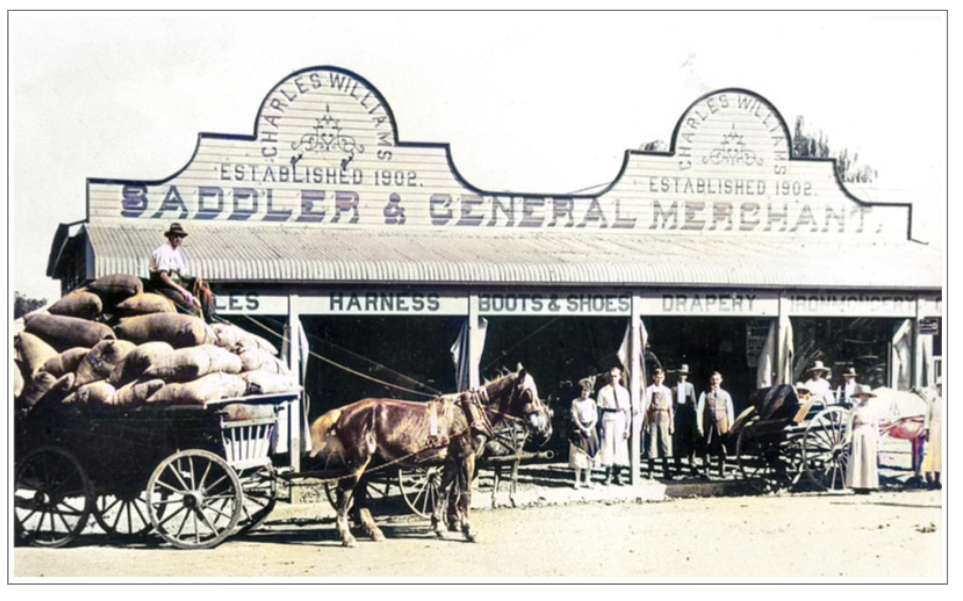
Rosewood History
Charles WILLIAMS and Louise Wilhelmine Caroline SPANN
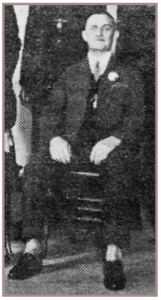 Name: Charles WILLIAMS
Name: Charles WILLIAMS
Occupation: Saddler, Draper, Grocer, General Store Keeper
Birth: 21st January 1881, Ipswich, Queensland
Residence: 67 Matthew Street, Rosewood, Queensland
Death: 21st January 1961, Brisbane, Queensland aged 80 years
Burial: Ipswich General Cemetery
Religion: Congregational
Father: John Barnett WILLIAMS
Mother: Jane GARLAND
Spouse: Louise Wilhelmine Caroline SPANN
Birth: 20th November 1879, Rosewood, Queensland
Residence: 1968 – 67 Matthew Street, Rosewood
Residence: 1972 – 1 Wongaburra St, Jindalee, Brisbane, Queensland
Death: 31st May 1977, Jindalee, Brisbane, Queensland aged 97 years
Burial: Ipswich General Cemetery
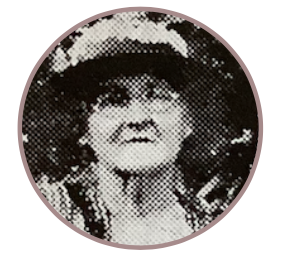 Religion: Congregational
Religion: Congregational
Father: August Ferdinand SPANN (Rosewood Sawmill)
Mother: Friedricka Wilhelmina Albertine STRENZEL
Marriage: 23rd May 1906, at the Central Congregational Church, Ipswich, Queensland
Children:
Doreen Spann WILLIAMS (1908-2003) = Claude William Joseph RICHARDSON (1911-1986)
The first six horses arrived in Australia in 1788 with the First Fleet. With more ships came more breeds of horses, and over time the population of strong, reliable horses (Walers) suited to the Australian conditions dramatically grew. They were the main form of transport for the new population to explore, carry goods and communicate in the early days, right up until they were slowly displaced in the early 20th Century by motor cars.
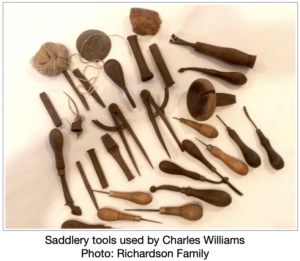 That being said, Saddlers were in great demand. They were skilled tradesmen who could apply their craft with multiple materials and styles. Saddlers were qualified to make, repair and maintain leatherwork including saddles, bridles, collars, sets of harness and other items like straps, sureingles and belts. Some of those necessary skills included being good at working with their hands, having creativity and a flair for design and construction and having a good knowledge of the anatomy of a horse. Good eyesight and an eye for detail was imperative, along with having the patience to work slowly and for long periods on a single task. Finally, Saddlers needed to be skilled in the use of a variety of tools. If a Saddler had all of these attributes, he could live comfortably.
That being said, Saddlers were in great demand. They were skilled tradesmen who could apply their craft with multiple materials and styles. Saddlers were qualified to make, repair and maintain leatherwork including saddles, bridles, collars, sets of harness and other items like straps, sureingles and belts. Some of those necessary skills included being good at working with their hands, having creativity and a flair for design and construction and having a good knowledge of the anatomy of a horse. Good eyesight and an eye for detail was imperative, along with having the patience to work slowly and for long periods on a single task. Finally, Saddlers needed to be skilled in the use of a variety of tools. If a Saddler had all of these attributes, he could live comfortably.
Charles Williams was such a man.
Charles had an interesting family history aside from that of his own making here in the town of Rosewood. His parents and his two elder sisters, Rose and Lily, immigrated from Gloucestershire aboard the Storm King in 1873. His paternal grandmother, four uncles and other relatives also came out. His father was a Stonemason by trade. His uncle Robert took up a selection near the town of Moore and he and his uncle Charles and cousin Frank built what is now the heritage listed former homestead “Stonehouse”, which is located on the D’Aguilar Highway at Moore in the Somerset Region of Queensland. It celebrated its 150th birthday on Saturday, July 27th, 2024.
Charles completed his apprenticeship in Saddlery at F. Goleby & Sons, cnr Brisbane and West Streets, Ipswich. Frederick John Goleby, Saddler, Harness and Collar Maker, was the founder of the business in 1881. He had a saddler’s shop at the above location in the Singer Machine Company’s old premises before building his own two storey building on the site, opening in February 1895. Charles walked from the suburb of One Mile to town each day to work a twelve hour day from 6 am to 6 pm.
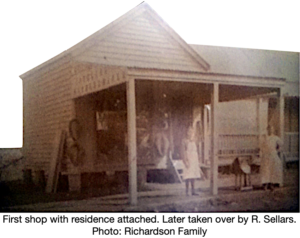
 In 1902 he started his own business in a small shop in Rosewood on the corner of William Street & John Street (where Drakes IGA is today).
In 1902 he started his own business in a small shop in Rosewood on the corner of William Street & John Street (where Drakes IGA is today).
In the early days of the business, he travelled between Rosewood and Grandchester. He used to sleep overnight under the counter before returning to Rosewood. – Errol Richardson (grandson)
Charles expanded his business and built a large new store next door (pictured above).
Robert Sellars from Milbong, opened up his fruit and refreshment room in Charles’s old shop in March 1903. (1)
In October 1904, a Salvation Army Fair was held in the Farmers’ Hall. There were stalls and competitions. A needle-threading and hat-trimming competition for gentlemen created considerable amusement. Charles won the former, and divided the honours with another gentleman for the latter.
Charles generously donated his hand-made bridles etc for prizes at local sports events. At 27th annual Show of the Rosewood Farmer’s Club in 1905, Charles won prizes for his saddlery. There were more prizes for Charles in future shows.
In May 1906 Charles married Miss Louise Spann in the Central Congregational Church at Ipswich. Her father was previously a proprietor of the Rosewood Sawmill and was at this time, proprietor of a mill in West Ipswich.
ORANGE BLOSSOMS. A very pretty wedding was solemnised in the Central Congregational Church on Wednesday afternoon, the 23rd instant, the contracting parties being Mr. C. Williams (son of Mr. J. B. Williams) and Miss Louise Spann (daughter of Mr. A. F. Spann, of West Ipswich). The officiating clergyman was the Rev. W. J. L. Closs, B.A., who was assisted by the Rev. A. E. West, of Rosewood. The bride, who was given away by her father, wore a handsome gown of silk crepe-de-chene on a silk foundation. The skirt, which was very full, was daintily trimmed with tiny vandyke kiltings of the material, edged with French Valenciennes lace, headed with insertion. The front panel and two of the side gores were trimmed with silk applique, the ends of each of the tiny kiltings being finished with a cluster of orange blossoms and chiffon rose-buds. The foot of the skirt was finished with a small kilted frill of the material, edged with lace, and headed with insertion. The bodice was extremely pretty, having a deep yoke of chiffon covered with Valenciennes insertion and frills of Valenciennes lace; elbow sleeves finished with kilted frills; long cuffs of net and Valenciennes lace; front of bodice finished with sprays of orange blossoms and chiffon roses. A beautifully embroidered veil and spray of orange blossoms completed this charming costume. The only ornamnent worn by the bride was a dagger-brooch, set with rubies and pearls (the gift of the bridegroom). She carried a lovely shower bouquet (also the gift of the bridegroom). As the bride entered the church leaning on the arm of her father the “Wedding March” was played by Mr. Sydney May. She was attended by three bridesmaids-Miss Spann (chief), Miss Williams, and Miss J. Spann-also two maids of honour-Miss Queenie Burns and Miss Gwladys Watkins, both of Rosewood. Mr. W. Williams (cousin of bridegroom) acted as best man, and Messrs. H. Eyre and J. Williams as groomsmen. The bridesmaids were gowned in cream silk-embroidered voile on glace foundation, and trimmed with glace kiltings and Victoria yokes, handsomely embroidered in silk stitchings. Miss Spann wore a very pretty hat of ombre pink, trimmed with chiffon and flowers, finished with chiffon scarf. Miss Williams’s hat was of blue, trinnmmed with blue chiffon flowers, and scarf. Miss J. Spann wore a pretty cream picture hat. Each bridesmaid carried a shower bouquet, and wore pretty gold brooches (gifts of the bridegroom). The bride’s travelling-dress was electric blue eolienne, trimmed with kiltings of silk, and handsomely embroidered gimp black picture-hat, with handsome ostrich plume, fastened with cut-steel buckle. The dresses worn by the two little maids of honour were:- Miss Queenie Burns, a pretty pink frock and bonnet to match. Miss Gwladys Watkins, a pretty blue frock and bonnet en suite. They wore gold brooches with their names inscribed thereon (the gift of the bride), and carried baskets of rose-leaves, which they strewed in front of the bride when coming out of the church. The sacred edifice was nicely decorated for the occasion, and suspended from an arch was a magnificent wedding-bell, the work of the girl friends of the bride. After the ceremony the bridal party proceeded to Mr. F. A. Whitehead’s studio for the purpose of being photographed. They then adjourned to the residence of the bride’s parents, where a sumptuos repast, prepared by Mr. F. W. Whitehouse, was partaken of. He also supplied the handsome three-tier wedding-cake, ornamented with lucky-slippers, bells, &c. After the customary toasts had been duly honoured Mr. and Mrs. Williams left for the railway station, where, amid showeirs of rice, confetti, and many good wishes, they left for the Tweed Heads, there to spend the honeymoon. The bride’s dress and millinery were obtained at the establishment of Messrs. Cribb and Foote.The bridesmaids’ dresses were purchased at Miss M’Guire’s. Both bride and bridegroom received many valuable and useful presents. (3)
In October 1909 Charles successfully applied for permission to extend his shop’s awning in John-street.
He lodged an appeal (July 1910) against the valuations of the Rosewood Shire Council for his allotments 17 to 28 of portion 283, 1r. 15p. each. The valuation of £240 was not altered.
At Christmas time the family went to Sydney for a month’s holiday.
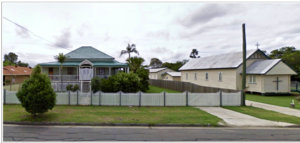
He lived in the big highest house next to the Lutheran Church, and in fact he donated the land for the church to be built. The house property then consisted of an orchard and large buggy shed at the rear, a large aviary and he bred prized poultry. – Barry Richardson (grandson)
Charles was the Superintendent of the Walloon Congregational Sunday school when it began in 1909. He became a Deacon in the Rosewood Congregational Church and Louise was a foundation member of the Ladies’ Guild there. Charles was also the secretary, and became president of the church’s newly formed Band of Hope in 1913, which was a society promoting lifelong abstention from alcohol among young people. Members were enrolled from the age of six and would meet to listen to addresses on temperance and participate in activities and competitions with other groups. Music played a big part and musical events, recitations, dialogues, choirs and lantern entertainments were enjoyed, as well as excursions and hymn singing while marching down the street.
Charles was also a member of the Success of Rosewood Lodge No. 22 P.A.F.S.O.A. and was elected as Worshipful Master in December 1908. In January 1911 he was presented with a P. M.’s collar (Past Master) and became Treasurer from January 1913, and Secretary from January 1916. It was a heavy blow to Charles when one of his good friends, long term employee, and fellow member of the Lodge, Charles Alfred Bernard Lubbock died in March that year. In June 1917 Charles had one of his fingers badly crushed in a machine and, as a consequence, he resigned as secretary of the lodge in July.
One of Charles’s apprentices was Gerald Vance Evans. After his term with Charles ended, Gerald became one of the first teachers at Marburg Rural School where he taught leather work. He started his classes in the refreshment booth at the showgrounds. He travelled between Boonah and Marburg and eventually became a school teacher at Goondiwindi.
For approximately one year in 1912, Charles opened a branch of his business in Patrick Street, Laidley. It was situated next to the Queensland National Bank.
On the night of 1st November 1913, a fire destroyed a house and shop in John Street owned by Charles Williams and occupied by butcher James Patrick Simmonds. Charles had purchased the shop and residence on the bottom side of his shop about a year before. An inquiry was held into the fire. Read it here.
These ads appeared in the Rosewood Register and Marburg Mail in November and December 1913.
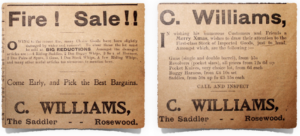 One Wednesday afternoon in March 1920, Charles’s horse and cart were standing at the sawmill when the animal bolted off and made its way up the main street. Before reaching Dow’s Bakery it crossed to the footpath. Mr. Clapshaw’s small child was standing in front of the shop and was knocked down, the wheel striking its head, and causing a severe gash. The cart overturned, the horse was secured, Dr Wallace was called and the little one received several stitches.
One Wednesday afternoon in March 1920, Charles’s horse and cart were standing at the sawmill when the animal bolted off and made its way up the main street. Before reaching Dow’s Bakery it crossed to the footpath. Mr. Clapshaw’s small child was standing in front of the shop and was knocked down, the wheel striking its head, and causing a severe gash. The cart overturned, the horse was secured, Dr Wallace was called and the little one received several stitches.
Members of the Congregational Church Guild and Christian Endeavour Society organised a surprise birthday party for Louise’s 42nd birthday. They arrived at the Williamses’ residence bringing all of refreshments needed. Rev. Cummings Air Capern, on behalf of those assembled, presented Louise Williams with a box of dainty handkerchiefs. On Louise’s behalf, Charles thanked everyone for the gift and for the pleasant evening.
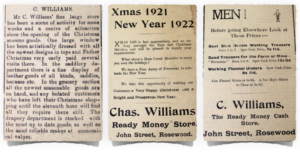
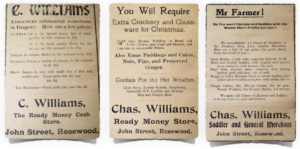 In the Rosewood the Magistrate’s Court on 1st May 1923, before Mr. R. J. J Hart J. P., Charles successfully proceeded against George Wetzig for £7/14/, goods sold and costs of court.
In the Rosewood the Magistrate’s Court on 1st May 1923, before Mr. R. J. J Hart J. P., Charles successfully proceeded against George Wetzig for £7/14/, goods sold and costs of court.
In 1924 he led the petition from 65 residents in Matthew Street for the street to properly built so heavy traffic could be driven along it.
In August 1925, Charles disposed of his drapery, grocery and produce business to Messrs. Carter and Duncalfe Ltd of Ipswich, who conducted a drapery in the premises. Charles retired aged 44 years. (Some years later, after Carter and Duncalfe closed their Rosewood branch, he opened another grocery business in his building with a manager and staff to conduct it.)
Bolt – A collision between several vehicles took place in John-street, Rosewood, this morning. Mr. W. Boughen’s horse, which was tied in front of Mr. C. Williams’ shop, bolted and collided with Mrs. Mason’s sulky. Mrs. Domrows’ spring cart was overturned in the disturbance. Fortunately, there there were no injuries, but Mr. Boughen’s sulky and harness were very much damaged, whilst the other two vehicles were slightly knocked about. (2)
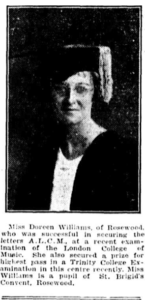 The Williamses’ talented daughter Doreen played the piano, guitar and organ and received a Diploma for Pianoforte playing with the rights to append the letters ALCM (Associate of the London College of Music) in December 1926.That same year she, as Superintendent of the Congregational Christian Endeavour Society, presented a pulpit bible to the church from the members. She played the at different concerts and occasions held in the town.
The Williamses’ talented daughter Doreen played the piano, guitar and organ and received a Diploma for Pianoforte playing with the rights to append the letters ALCM (Associate of the London College of Music) in December 1926.That same year she, as Superintendent of the Congregational Christian Endeavour Society, presented a pulpit bible to the church from the members. She played the at different concerts and occasions held in the town.
Thieves attempted to break into Charles’s store in 1931 by smashing the lock on the front doors. Arthur Capern, an employee in the store, arrived to open up the morning, discovered that the six-lever lock had been tampered with. The lock was too strong for the burglars’ efforts and they went elsewhere. Charles and the staff had to gain entrance by the back way and remove the staple on the front door before it could be opened.
In February and March 1932, the news from Rosewood was that Mr. Charles Williams was very ill at his home, suffering from heart problems, but he was slowly recovering.
A social and presentation was held at the Congregational Church for five church members who were absent from the district. Charles and Louise were way from Rosewood because they were holidaying at Redcliffe at the time, so Doreen attended and accepted a gift on their behalf. Read the article here.
Doreen married Claude Richardson on 10th April 1937 at the Central Congregational Church in Ipswich. Claude was the son of Edward Walter Richardson and Jessie Campbell née Shearer. Richardson-Williams Wedding
Louise was a member of the Congregational Ladies Guild for 21 years and was present for their 21st Anniversary in June 1937 to cut the cake at the celebrations. The cake was made by Mrs Agnes Harding and decorated by Mrs Ruby Harding.
At the breaking up of the Rosewood Congregational Sunday School in 1950, presentations of framed testimonials, along with gifts of fountain pens, were made to four members of the church who had given 20 years or more service as officers in the work of the church. Rev. Joseph Dyer made the presentations to Messrs. Chas. Williams, Chas. Wass, S. R. Harding and J. P. Rea, all of whom responded and said they hoped that they would be spared for many years to come to continue the work.
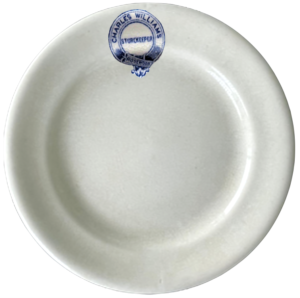 Charles was a savy businessman. His business acumen and hard work enabled him to invest in real estate. He owned two rental houses and other property in Matthew St. In April 1952 these houses were being rented for 16/6 per week and tenanted by Alexander Russell Dick and Walter Elliott. Their rent was increased by 12/- by the Rosewood Fair Rents Court that month. Charles also owned a holiday house, two flats and a rental house in Redcliffe.
Charles was a savy businessman. His business acumen and hard work enabled him to invest in real estate. He owned two rental houses and other property in Matthew St. In April 1952 these houses were being rented for 16/6 per week and tenanted by Alexander Russell Dick and Walter Elliott. Their rent was increased by 12/- by the Rosewood Fair Rents Court that month. Charles also owned a holiday house, two flats and a rental house in Redcliffe.
He was a keen gardener and fisherman and won prizes for showing his poultry and other birds at the Rosewood Show. Charles donated trophies for the shows and for other occasions like the Rosewood Railway Ambulance Classes. He also donated bridles, sureingles and harnesses so they could be used as prizes for the different events.
After Charles died in 1961, Louise stayed in Rosewood until about 1970, when she moved to Jindalee to live with Doreen and Claude until her death in 1977.
Charles and Louise are interred in the Ipswich General Cemetery.
See more of Charles Williams’s advertisements here.
Snippets from the family:
He commenced a saddlery business in John Street and later expanded to a general store where the IGA stands today. He employed the Sellars brothers and eventually sold the business to them. – Barry Richardson (grandson)
In my time that shop sold everything from groceries to produce, to hardware etc i.e. a general store. I believe it developed into that from the saddlery business. He was a Deacon of the Congregational Church and Secretary of the Success of Rosewood Lodge (for 22 years) a branch of the Protestant Alliance Friendly Society of Australasia. Charles retired at about age 44 and the shop was leased to others. In my youth it was known as Capern & Baills.- Errol Richardson (grandson)
He donated the stained glass windows in the front of the Congregational Church in John St (opened in March 1954) and I think they are still there today. He claimed to have owned the first motorised buggy in Rosewood. – Barry Richardson (grandson)
Not sure about the first car, my mother always said it was the first car in Rosewood, certainly Charles’s first. – Errol Richardson (grandson)
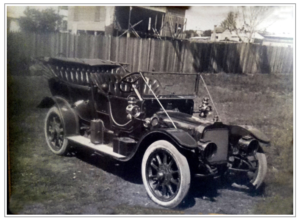
Rosewood’s first motor car arrived in October 1908 and was the property of Mr. William Edward Collett. It was a dark red single seater. It was an object of interest when it first appeared in the streets of Rosewood. Charles Williams’s car (pictured) could well have been the second. It certainly made an attractive adornment around the town.
© Jane Schy, 2024
Sources:
Main photo: Courtesy of Barry Richardson (coloured by Jane)
(1) Queensland Times, Ipswich Herald & General Advertiser, Saturday, 7 March 1903, page 7
(2) Queensland Times, Friday, 23 October 1925, page 10
(3) Queensland Times, Ipswich Herald and General Advertiser, Tuesday, 29 May 1906, page 2
